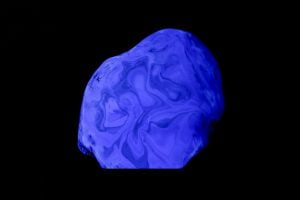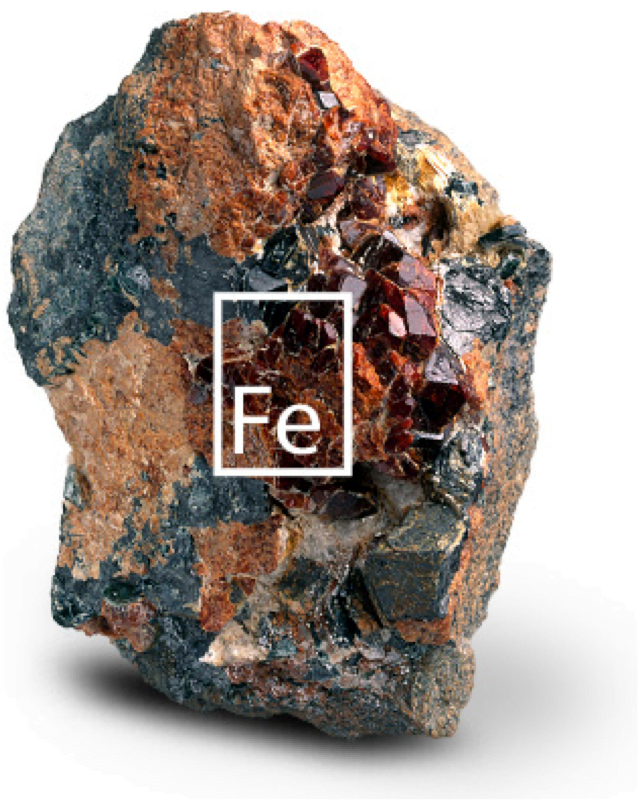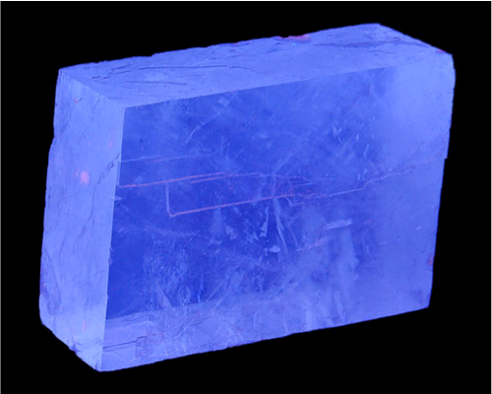An Exhibition of a Galaxy of Glowing Gems
As part of the 2016 Singapore Night Festival showcase, The Gem Museum and Far East Gems and Jewellery put together a special exhibition of gemstones and minerals that come to live in the dark!
Here’s what we did: We turned off all the lights in the museum, turning the entire space into a wonderland of glowing gemstones.
So nice, they are glowing gems!
 An Amber fluoresces blue under long wave UV light.
An Amber fluoresces blue under long wave UV light.
Petroleum in Quartz from Pakistan. The petroleum flouresces yellow!
A beautiful pieces of spinel in marble matrix. The spinel fluoresces red under long wave UV light.
For visitors to the museum, it was a sight to behold. And I was delighted to see more than a hundred people attended the event – many are at the museum for their first time! On display were over 200 gemstones and mineral samples from Far East Gem Institute’s collection that showcases the natural fluorescent and properties of the gems, crystals and minerals. Additionally, we have put together a special presentation explaining how and why certain types of gemstones and minerals react under specific lighting conditions that dramatically transform the way they look.
Some interesting facts about glowing gemstones
- Only about 15% of minerals have a fluorescence that is visible to people and some specimens of those minerals will not fluoresce.
- Fluorescence usually occurs when specific impurities known as “activators” are present within the mineral.
- These activators are typically cations of metals such as: tungsten, molybdenum, lead, boron, titanium, manganese, uranium and chromium.
- Rare earth elements such as europium, terbium, dysprosium, and yttrium are also known to contribute to the fluorescence phenomenon.
- Fluorescence can also be caused by crystal structural defects or organic impurities.
- In addition to “activator” impurities, some impurities have a dampening effect on fluorescence.
- If iron or copper are present as impurities, they can reduce or eliminate fluorescence.
- Furthermore, if the activator mineral is present in large amounts, that can reduce the fluorescence effect.
- Most minerals fluoresce a single colour. Other minerals have multiple colours of fluorescence.
- Calcite has been known to fluoresce red, blue, white, pink, green and orange.
Pic: Calcite fluorescing in different colours.
- Some minerals are known to exhibit multiple colours of fluorescence in a single specimen.
- These can be banded minerals that exhibit several stages of growth from parent solutions with changing compositions.
Pic: Banded rock materials that fluoresces different colours under UV.
An important aspect…
- In the early 1900s, many diamond merchants would seek out stones with a strong blue fluorescence.
- They believed that these stones would appear more colourless (less yellow) when viewed in light with a high ultraviolet content.
- This eventually resulted in controlled lighting conditions for colour grading diamonds.
Getting ready for next year!
This year, we had a successful exhibition on a Galaxy of Glowing Gemstones. Coming up next year, Singapore 10th Night Festival 2017, we are going to exhibit the theme of Galaxy of Moons and Stars! Do keep a lookout!
Pic: Star Sapphire
References:
http://theonlinejeweller.org/wp-content/uploads/2014/12/fluorescence-of-all-colors-for-post.jpg
http://geology.com/articles/fluorescent-minerals/fluorescence.gif
http://geology.com/articles/fluorescent-minerals/
https://images.sciencedaily.com/2010/11/101117184451_1_900x600.jpg
http://florence20.typepad.com/.a/6a00d83452a77469e201675eb5dd76970b-800wi
http://8562-presscdn-0-52.pagely.netdna-cdn.com/wp-content/uploads/2015/07/iron-ore-lump-2015-07-09_1507.png
http://www.devonbuy.com/wp-content/uploads/2014/05/Native-Copper-Michigan-USA.jpg
https://02f0a56ef46d93f03c90-22ac5f107621879d5667e0d7ed595bdb.ssl.cf2.rackcdn.com/sites/3660/photos/146309/L-fluorescent-minerals-ultraviolet-20130718_152620151122-27755-besbh8_960x.jpg
http://geology.com/articles/fluorescent-minerals/fluorite.jpg
https://s-media-cache-ak0.pinimg.com/564x/32/6b/ed/326bed6679e50412d7faf42dd8bb8aec.jpg
http://geology.com/articles/fluorescent-minerals/
http://www.artinnaturephotography.com/wordpress/wp-content/uploads/2010/02/Scheelite.jpg
http://www.marinmineral.com/db_pics/pics/a248b.jpg
https://s-media-cache-ak0.pinimg.com/236x/a2/2b/5f/a22b5f22543aae747216141090ad9d78.jpg
http://lotusgemology.com/images/library/articles/sourcearticles/pigeons-blood/silk-fluorescence.jpg
https://i.ytimg.com/vi/XY5_neHP5aU/maxresdefault.jpg
http://www.gia.edu/images/162040_Fig11_468x468_1355965398367.jpg
http://www.thenakedscientists.com/HTML/uploads/RTEmagicC_DiamondView_image_of_a_natural_diamond_01.bmp.jpg
http://www.ruby-sapphire.com/heat_seeker_uv_fluorescence.htm
http://www.starruby.in/store/images/large/Star-Rubies/SRA1690-1.89-carat-star-ruby_LRG.jpg














